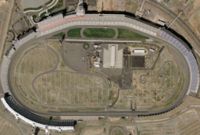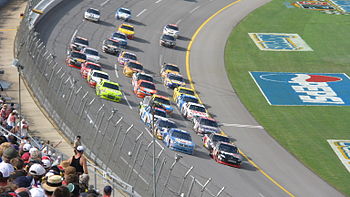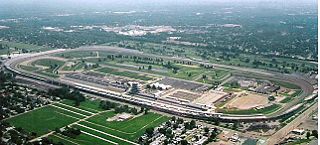- Oval track racing
-
Oval track racing, also known as oval racing, is a form of closed-circuit automobile racing that is contested on an oval-shaped track. An oval track differs from a road course in that the layout resembles an oval with turns in only one direction, almost universally left (counter-clockwise orientation). Oval tracks are dedicated motorsport circuits, used predominantly in North America. They often have banked turns and most, despite the name, are not precisely oval, and can have unique variances in shape.
Martinsville Speedway, a symmetrical oval, following a race.
Oval racing involves racing cars wheel-to-wheel around the track. Major forms of oval racing include stock car racing, sprint car racing, and some forms of open-wheel racing. Among the most famous oval tracks in North America are the Indianapolis Motor Speedway and Daytona International Speedway.
Contents
Track classification (size)
Oval tracks are classified based upon their size, surface, and shape. Their size can range from only a few hundred feet to over two and a half miles. Track surfaces can be dirt, concrete, asphalt, or a combination of concrete and asphalt. Some ovals in the early twentieth century had wood surfaces.
The definitions used to differentiate track sizes have changed over the years. It should be noted that while some tracks use terms such as "speedway" or "superspeedway" in their name, they may not meet the specific definitions set in this article. At times, the specific terms used to describe the tracks can be ambiguous or loosely defined.
The typical oval track consists of two straights, connected by two 180° turns. Although most ovals generally have only two radii curves, they are usually advertised and labeled as four 90° turns.
Short tracks
Main article: Short track motor racingA short track is an oval less than 1.0 miles (1.6 km) long. Short tracks are often used as a starting point for drivers seeking careers in oval track racing. Professional-level examples include Bristol, Martinsville and Richmond.
Mile ovals
Synonymous with the name, a 1-mile (1.61 km) oval is a popular and common length for oval track racing. The exact measurements, however, can vary by as much as a tenth of a mile and still fall into that category. Most mile ovals are relatively flat-banked, with Dover being a notable exception. Other examples include Phoenix, Milwaukee and Nazareth. Due to their short length and fast speeds, these tracks are often nicknamed "bullrings."
Intermediate tracks
Also referred to with the general term of "speedways," these courses are 1 to 2 miles (1.6 to 3.2 km) in length, but the term is particularly reserved for 1.5-mile (2.4 km) tracks. Since their size allows them to compromise high speeds with sightlines, they have become commonplace in major racing series that utilize oval tracks. During the race track construction boom of the 1990s, these tracks began to be labeled with the rather derogatory term "cookie cutter" tracks, as their differences were perceived to be minimal. Examples include Las Vegas, Kansas, and Chicagoland.
Superspeedways
Superspeedways are at least 2.0 miles (3.2 km) in length. The most famous superspeedways are Indianapolis Motor Speedway and Daytona International Speedway. These tracks were built in 1909 and 1959 respectively. Indianapolis Motor Speedway was built as a facility for the automotive industry to conduct research and development.[1] Daytona International Speedway was built as a replacement for the Daytona Beach Road Course, which combined the town's main street and its famous beach, the track holds the Daytona 500, NASCAR's most prestigious race.
The longest superspeedway is the Talladega Superspeedway in Talladega, Alabama. Built in 1969, it is 2.66 miles (4.28 kilometers) long, and holds the current record for fastest speed in a stock car, 228 miles per hour (367 km/h).[2] Daytona and Talladega are the pinnacle of stock car superspeedway racing, and they require restrictor plates due to their high banking and otherwise high speed.
Other superspeedways used by NASCAR include the Fontana, Michigan, and Pocono. Fontana and Michigan are often considered intermediate tracks due to their similarities with other 1.5 mile tracks, while Pocono and Indianapolis are sometimes classified separately, as they are the only long, flat tracks on the schedule.
Track classification (shape)
While many oval tracks conform to the traditional symmetrical design, asymmetrical tracks are not uncommon. Pocono Raceway, for example, has the shape of a scalene triangle with rounded corners. Darlington Raceway was built with an egg-shape to accommodate a nearby minnow pond. Tracks that are built in the traditional "oval" shape include Homestead and Dover. Prior to its reconfiguration in 1997, Atlanta also conformed to this design.
Paper clip ovals
One sub-classification of the traditional oval shape is the "paper clip" oval. The layout consists of two long straights, connected by two sharp, tight-radius turns, giving the track a shape resembling a paper clip. The courses are usually very challenging, and usually offer little banking, making the turns very slow and tight to maneuver. Notable "paper clip" ovals include Loudon and Martinsville.
Tri-ovals
Tri-ovals have become preferable to track builders as they offer superior sightlines. A tri-oval resembles an isosceles triangle with rounded-off corners.
The 1990s race track construction boom of 1 ½ mile tri-oval shaped tracks has given these tracks a "cookie-cutter" label.[3]
Doglegs
Some oval tracks have minor variations, such as kinks or doglegs. A "dogleg" is a defined as a soft curve down one of the straights, either inward or outward, which skews the oval into a non-sysmetric or non-traditional shape. Phoenix is one example of a dogleg shape. While the extra curve would seemingly give the oval 5 turns, the dogleg is normally omitted from identification, and the ovals are still labeled with 4 turns. Trenton Speedway had a unique right-hand dogleg, giving the track what was called a "kidney bean" shape.
Quad-oval
A tri-oval with a "double dogleg" is often called a "quad-oval". The first such was Charlotte built in 1960. The shape has become a signature for SMI, which owns the other two major quad-ovals, Atlanta and Texas.
D-shaped oval
Another common shape variation is the "D-Shaped oval." Similar to a tri-oval, the D-Shaped oval has a straight backstrech, but a long, sweeping frontstrech, giving the circuit a layout resembling the letter "D." The shape originated with a pair of "sister tracks" built in the 1960s: Michigan and Texas World. Auto Club Speedway, built in 1997, was built to the same configuration.
Rovals
A "Roval," sometimes referred to as a "Combined road course", is an oval track racing facility that features a road course in the infield (or outfield), that may or may not be directly linked to the oval circuit. The name is a portmanteau of road course and oval. A roval allows the facility to be used for road racing (Formula One, sports cars, motorcycles, etc.) Some classes of racing do not allow a full oval, and therefore would not have the ability to otherwise compete at some of the most famous speedways in the world.
 Charlotte Motor Speedway, a quad-oval, with its infield road course and legends oval visible.
Charlotte Motor Speedway, a quad-oval, with its infield road course and legends oval visible.
Rovals typically consist of the oval portion of the track, utilizing the same start/finish line, and same pit area, but a mid-course diversion to a winding road circuit in the infield. At some point, the circuit leads back to the main oval, and completes the rest of the lap. On some of the faster ovals, a chicane is present on long back-straights, to keep speeds down, and create additional braking/passing zones.
Rovals combine the high speed characteristics of ovals and technical precision of road courses, and allow road racing the unique experience of being held in the "stadium style" atmosphere of an oval superspeedway. Since 1962, the Rolex 24 Hours of Daytona has been one of the most notable roval races. However, due to the limitations of infield dimensions, and the common lack of topography, rovals often compromise the road racing experience. While the oval’s sightlines are popular, some fans may feel that the racing itself is lackluster.[4] In many cases, the grandstand seating around the oval offers the least popular view of the road racing, as fans are drawn to observe from the more challenging infield portion.
Notable rovals (U.S.)
- Indianapolis Motor Speedway
- Combined road course was built in 2000 for the U.S. Grand Prix, and reconfigured in 2008 for the Red Bull G.P.
- Daytona International Speedway
- Home of the 24 Hours of Daytona and Daytona 200
- Talladega Superspeedway
- Former; course was used by last used professionally by IMSA in 1978. Infield road course was abandoned and converted into infield access roads.
- Atlanta Motor Speedway
- Charlotte Motor Speedway
- Texas Motor Speedway
- Auto Club Speedway (several configurations)
- Michigan International Speedway
- Former; an unusual 1.9-mile (3.1 km) clockwise infield road course was used in the 1970s, and by SCCA Club Racing in the 1980s. It was abandoned in the 1990s for racing but used by Michigan authorities to test patrol cars.
- Texas World Speedway
- The original combined road course at TWS featured a sizeable "outfield" portion and has multiple layouts. The oval is used for testing to evade NASCAR's ban on testing while SCCA club racing takes place at the College Station road courses.
- Homestead-Miami Speedway- used by the Rolex Sports Car Series
- Phoenix International Raceway
- An infield road course was built in the early 1990s. An outfield road course was abandoned in 2003 after track revisions that sealed both openings on the dogleg backstretch. Used by the Rolex Sports Car Series for seven years.
- Pikes Peak International Raceway
- Mid-Ohio Sports Car Course
- Primarily a road course; in 2006, a motorcross oval was the paved connecting the two straights. The improvements created in total 3 road course layouts, and 2 motorcross oval layouts.
- New Hampshire Motor Speedway
- Iowa Speedway
Notable rovals (international)
- Twin Ring Motegi (road course at ground level, oval course raised)- used for the Japanese IndyCar Series race
- Calder Park Thunderdome (no infield course but outfield course connected to oval) (located in Australia)
- Rockingham Motor Speedway
- Autódromo Hermanos Rodríguez (an former oval layout was available, connecting the mainstrech with the backstrech, and using the existing turn 14, Peraltada).
- EuroSpeedway Lausitz
- Autodrome de Montlhéry
- Brooklands
- Autodromo Nazionale Monza (oval portion is now abandoned)
- AVUS (disused in favour of the newly constructed permanent EuroSpeedway Lausitz)
- Fuji Speedway (former; originally built as an oval, was then converted to half oval which was used until 1974)
- Mallory Park
- Phakisa Freeway
The term rovals can also be used to loosely describe an oval track with an asymmetrical, unusual, or oblong shape. While these speedways are still technically ovals, their unique shape often produces driving characteristics similar to those of a road course.
Notable asymmetrical rovals
- Pocono Raceway (triangular oval, with three distinct, widely varying turns)
- Pocono also has several combined road course layouts
- Emerson Fittipaldi Speedway (a very flat oval course was used for IndyCars)
- Trenton Speedway (had a "kidney bean" shape with a kink in the backstretch)
Legends ovals
In 1991, Charlotte Motor Speedway created the first notable "Legends" oval course. The existing quad oval start/finish straight was connected to the pit lane by two 180 degree turns, resulting in a 1/4-mile short track oval. A special exhibition race featuring former NASCAR legends headlined one time on the course.
A year later, the same 1/4-mile layout became a popular venue for Legends car racing. The name "Legends oval" was derived from this use. They have also seen use with go-karts, short track stock cars, and other disciplines.
The Legends oval concept allows minor league levels of racing to compete in the stadium-style atmosphere of large speedways, when they would normally be confined to small, stand-alone 1/4-mile venues. It also allows them to serve as support races at tracks where they would not normally be able to compete (due to the track lengths and speeds) without track or car modification.
Tracks with Legends ovals
- Charlotte Motor Speedway
- Texas Motor Speedway
- Atlanta Motor Speedway
- Kentucky Speedway (The original oval only connected to pit straight due to curved tri-oval)(A new Legends Oval was build in 2011 for Kentucky because of the updated pit road for the NASCAR Sprint Cup race at Kentucky)
- Las Vegas Motor Speedway (connects to tri-oval apron due to track banking)
- Iowa Speedway (1/8 miles in length)
- Pocono Raceway
- Former; Pocono had a 3/4-mile oval which connected to the mainstrech, and circled around the garage area. The track was mainly used for the Race Of Champions Modified races and other short track type racing such as Late Models and other divisions. It was razed when the garage area was expanded in the late 1990s.
Pack racing
 Pack racing at Talladega Superspeedway.
Pack racing at Talladega Superspeedway.
Pack racing is a phenomenon found on fast, high-banked superspeedways. It occurs when the vehicles racing are cornering at their limit of aerodynamic drag, but within their limit of traction. This allows drivers to race around the track constantly at wide open throttle. Since the vehicles are within their limit of traction, drafting through corners will not hinder a vehicle’s performance. As cars running together are faster than cars running individually, all cars in the field will draft each other simultaneously in one large pack. In stock car racing this is often referred to as “restrictor plate racing” because NASCAR mandates that each car on its two longest high-banked ovals, Talladega and Daytona, use an air restrictor to reduce horsepower.
The results of pack racing may vary. As drivers are forced to race in a confined space, overtaking is very common as vehicles may travel two and three abreast. This forces drivers to use strong mental discipline in negotiating traffic. There are drawbacks, however. Should an accident occur at the front of the pack, the results could block the track in a short amount of time. This leaves drivers at the back of the pack with little time to react and little room to manoeuvre. The results are often catastrophic as several cars may be destroyed in a single accident. This type of accident is often called "The Big One". NASCAR drivers have developed strategies to form smaller packs (2 Car Draft) away from the lead pack early in a race. This gives them extra reaction time in event of a crash.[5]
Comparison with road racing
Oval track racing requires different tactics than road racing. While the driver doesn’t have to shift gears as frequently or brake as heavily as in road racing, drivers are still challenged by negotiating the track. Each type of racing places physical demands on the driver. A driver in an IndyCar race at Richmond International Raceway may be subject to as many lateral g-forces as a Formula One driver at Istanbul Park.
Weather also plays a different role in each discipline. Road racing offers a variety of fast and slow corners that allow the use of rain tires. Paved ovals cannot support rain tires because the turns are all very fast and the soft rubber compound used in the tread would not survive long against the forces inflicted upon it. Dirt ovals will sometimes support a light rain. Some tracks (Evergreen Speedway in Monroe, WA) have "rain or shine" rules requiring races to be run in rain.
Safety has also been a point of difference between the two. While a road course usually has abundant run-off areas, gravel traps, and tire barriers, ovals usually have a concrete retaining wall separating the track from the fans. Innovations have been made to change this, however. The SAFER barrier was created to provide a less dangerous alternative to a traditional concrete wall. The barrier can be retrofit onto an existing wall or may take the place of a concrete wall completely.
See also
References
- ^ Indystar.com"History of the Indianapolis 500" Retrieved November 19, 2007
- ^ NASCAR.com – Rusty Wallace hits 228 mph (367 km/h) in Talladega trial – June 10, 2004
- ^ USAToday article on "cookie-cutter" tracks
- ^ [1]
- ^ CNNSI"Hangin' Back" retrieved November 17, 2007
Categories:- Auto racing by type
- Stock car racing
- Open wheel racing
- Indianapolis Motor Speedway
Wikimedia Foundation. 2010.



